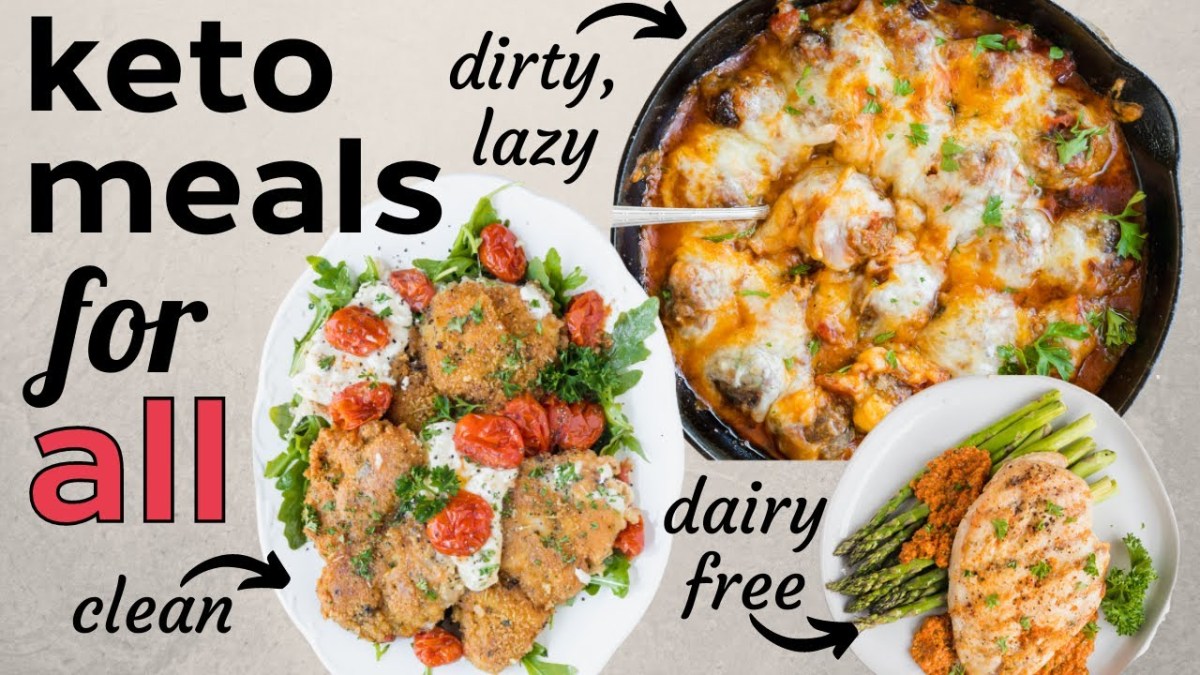Embark on a culinary journey to vibrant health with our guide to starting a low-carb diet. We’ll demystify the process, providing simple, delicious recipes and practical strategies to navigate this lifestyle change. Discover how to effortlessly incorporate low-carb principles into your daily life, transforming your meals and feeling energized along the way. Learn to swap high-carb favorites for satisfying low-carb alternatives, making the transition smooth and enjoyable.
From understanding the fundamentals of low-carb eating to mastering simple, yet flavorful recipes, this guide provides a comprehensive roadmap. We’ll explore various low-carb approaches, helping you find the perfect fit for your individual needs and preferences. We’ll also address common challenges and offer solutions for long-term success, ensuring you’re equipped with the knowledge and confidence to embrace a healthier, low-carb lifestyle.
Planning Your Low-Carb Meals
Embarking on a low-carb diet doesn’t mean sacrificing delicious and satisfying meals. Careful planning is key to success, ensuring variety, managing hunger, and preventing common pitfalls. This section will guide you through creating a week’s worth of low-carb meals, focusing on simplicity and deliciousness.
A well-structured low-carb meal plan provides a roadmap to healthy eating, preventing impulsive, less-healthy choices. By incorporating a variety of flavors and textures, you’ll stay engaged and avoid feeling restricted. Furthermore, planning ahead saves time and reduces stress, crucial factors in maintaining any dietary change.
A Sample Weekly Low-Carb Meal Plan
This sample plan prioritizes ease of preparation and incorporates diverse flavors. Remember to adjust portion sizes based on your individual caloric needs and activity levels.
| Day | Breakfast | Lunch | Dinner |
|---|---|---|---|
| Monday | Scrambled eggs with spinach and feta cheese | Large salad with grilled chicken and avocado | Salmon with roasted asparagus and cauliflower mash |
| Tuesday | Greek yogurt with berries and a sprinkle of chia seeds | Leftover salmon and asparagus | Chicken stir-fry with shirataki noodles and plenty of vegetables (broccoli, peppers, onions) |
| Wednesday | Omelet with mushrooms and cheese | Tuna salad (made with mayonnaise) lettuce wraps | Steak with green beans and a side salad |
| Thursday | Bulletproof coffee (coffee with butter and MCT oil) | Leftover steak and green beans | Pork chops with roasted Brussels sprouts and zucchini |
| Friday | Cottage cheese with sliced almonds | Large salad with hard-boiled eggs and avocado | Shrimp scampi with zucchini noodles |
| Saturday | Bacon and eggs | Leftover shrimp scampi | Chicken and vegetable skewers with a side salad |
| Sunday | Breakfast sausage and avocado | Leftover chicken skewers | Roast chicken with roasted root vegetables (carrots, parsnips) |
Common Pitfalls to Avoid
Starting a low-carb diet can present challenges. Understanding common pitfalls helps prevent setbacks and fosters long-term adherence.
- Insufficient Fiber Intake: Prioritize non-starchy vegetables to prevent constipation. Think leafy greens, broccoli, cauliflower, and asparagus.
- Electrolyte Imbalance: Low-carb diets can initially deplete electrolytes like sodium, potassium, and magnesium. Increase your intake through foods like bone broth, salted nuts, and leafy greens, or consider electrolyte supplements as advised by your doctor.
- Nutrient Deficiencies: Focus on whole, unprocessed foods to ensure adequate vitamin and mineral intake. Consider a multivitamin if needed, after consulting your doctor.
- Overly Restrictive Approach: Avoid overly restrictive diets. Allowing for occasional indulgences (in moderation) can improve adherence.
Managing Hunger and Cravings
Hunger and cravings are common initial challenges. Employing effective strategies can mitigate these feelings.
- Increase Protein and Healthy Fat Intake: Protein and fat promote satiety, reducing hunger pangs between meals. Think lean meats, eggs, avocados, nuts, and seeds.
- Drink Plenty of Water: Often, thirst is mistaken for hunger. Staying well-hydrated helps curb appetite.
- Mindful Eating: Pay attention to your body’s hunger and fullness cues. Eat slowly and savor your meals.
- Identify and Address Underlying Cravings: Are you craving sugar? Perhaps you need more healthy fats or electrolytes. Addressing the root cause is crucial.
Weekly Low-Carb Grocery List
This list provides a framework; adjust quantities based on your needs and preferences.
| Category | Items |
|---|---|
| Proteins | Chicken breasts, salmon fillets, steak, pork chops, eggs, bacon, sausage, shrimp, canned tuna |
| Vegetables | Spinach, broccoli, cauliflower, asparagus, green beans, Brussels sprouts, zucchini, lettuce, avocado, onions, peppers, carrots, parsnips |
| Healthy Fats | Avocado oil, olive oil, butter, coconut oil, nuts (almonds, walnuts), seeds (chia, flax) |
| Dairy & Alternatives | Greek yogurt, cottage cheese, full-fat cheese (feta, cheddar) |
| Other | Mayonnaise, spices, herbs, bone broth, salt |
Adapting Recipes to Be Low-Carb

Embarking on a low-carb journey doesn’t mean sacrificing the joy of cooking and eating your favorite meals. With a little creativity and substitution savvy, you can transform many high-carb recipes into delicious, low-carb delights. This involves understanding which ingredients contribute the most carbohydrates and then strategically replacing them with low-carb alternatives. The key is to maintain the flavor and texture you love while significantly reducing the carb count.
Many beloved recipes rely heavily on carbohydrates for structure and flavor. Pasta dishes, for instance, depend on pasta for their foundation, while bread-based meals utilize bread as a primary component. However, these high-carb staples can be easily replaced with low-carb alternatives that provide similar textures and culinary experiences. This section will explore effective methods for adapting recipes, providing specific examples of substitutions, and showcasing how to create low-carb versions of popular dishes.
Low-Carb Substitutions for Common Ingredients
The foundation of adapting high-carb recipes lies in swapping out the carb-heavy ingredients. This often involves substituting starches and grains with low-carb alternatives that mimic their texture and functionality. Imagine a vibrant plate of zucchini noodles substituting for traditional pasta, or cauliflower rice offering a lighter, subtly sweet alternative to white rice. These changes significantly reduce the carbohydrate content without compromising the overall taste and satisfaction of the dish.
- Pasta: Replace traditional pasta with zucchini noodles (zoodles), spaghetti squash, shirataki noodles (made from konjac yam), or kelp noodles. Zoodles offer a delicate texture and absorb sauces beautifully; spaghetti squash provides a naturally sweet and slightly firm alternative; shirataki noodles are nearly flavorless and have a unique, slightly jelly-like texture, excellent for absorbing bold flavors; and kelp noodles provide a unique slightly chewy texture and are perfect for cold dishes.
- Bread: Opt for cloud bread (made with eggs and cream cheese), almond flour bread, coconut flour bread, or portobello mushroom caps. Cloud bread offers a light and airy texture; almond flour bread provides a slightly nutty flavor and denser texture; coconut flour bread gives a naturally sweet and slightly crumbly texture; and portobello mushrooms offer a hearty, meaty base for sandwiches and burgers.
- Rice: Cauliflower rice, shirataki rice, or a combination of finely chopped vegetables like broccoli, carrots, and zucchini can replace rice. Cauliflower rice provides a light and slightly sweet flavor; shirataki rice has a similar texture to white rice, but with almost no taste, making it ideal for dishes with strong flavors.
Creating Low-Carb Versions of Popular Dishes
Let’s delve into the practical application of these substitutions. Transforming beloved dishes into low-carb versions requires a mindful approach, focusing on maintaining the essence of the original while minimizing carbohydrate intake. This involves not only substituting ingredients but also sometimes adjusting cooking methods to achieve the desired results. For example, while cauliflower rice cooks quickly, spaghetti squash requires a longer roasting time.
Low-Carb Pizza
Instead of a traditional wheat-based crust, use a cauliflower crust, portobello mushroom cap, or a thin crust made from almond flour. The toppings remain largely the same, focusing on vegetables, lean proteins, and low-carb cheese. Visualize a thin, crisp crust, speckled with the vibrant colors of peppers, onions, and mushrooms, topped with melted mozzarella and a sprinkle of herbs.
Low-Carb Pasta
Imagine a vibrant plate of zoodles tossed in a rich tomato sauce, adorned with succulent meatballs and a dusting of parmesan cheese. The zucchini noodles, while visually different from traditional pasta, provide a satisfying texture and absorb the sauce beautifully. This dish showcases how a simple substitution can create a low-carb meal that’s both healthy and delicious.
Low-Carb Baking Substitutions
Successfully baking low-carb treats requires understanding how to replace traditional flour and sugar. The following substitutions will help you create delicious and satisfying low-carb baked goods.
- Flour: Almond flour, coconut flour, oat fiber, flaxseed meal, or a blend of these can replace wheat flour. Almond flour provides a slightly nutty flavor and a tender crumb; coconut flour absorbs more liquid and creates a denser texture; oat fiber offers a neutral flavor and adds bulk; flaxseed meal adds moisture and a slightly nutty flavor.
- Sugar: Erythritol, stevia, monk fruit, or xylitol can substitute for sugar. Erythritol has a similar sweetness to sugar; stevia is very sweet, requiring less; monk fruit provides a mild sweetness; and xylitol has a cooling effect.
- Leavening Agents: Baking powder and baking soda are still crucial for rise and texture in low-carb baking. Their functionality remains unchanged in low-carb recipes.
Mastering a low-carb diet is a journey of discovery, filled with delicious possibilities and positive health outcomes. By understanding the core principles, embracing simple recipes, and planning strategically, you can transform your relationship with food and unlock a new level of well-being. Remember, consistency and mindful choices are key to long-term success. So, start cooking, start feeling great, and embark on your low-carb adventure today!
User Queries
What are the best low-carb snacks to curb cravings?
Celery sticks with almond butter, hard-boiled eggs, a handful of almonds, or avocado slices are excellent choices to satisfy hunger between meals.
Can I still eat out on a low-carb diet?
Yes, choose restaurants with options like grilled meats, salads without creamy dressings, and vegetables. Be mindful of hidden carbs in sauces and breading.
How long does it take to see results on a low-carb diet?
Results vary, but many people experience weight loss and improved energy levels within the first few weeks. Consistency is key.
Are there any potential downsides to a low-carb diet?
Potential downsides include nutrient deficiencies if not planned carefully, “keto flu” initially (headaches, fatigue), and constipation. Consult your doctor before starting.


